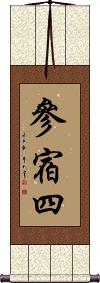Many custom options...
And formats...

Heike Star Betelgeuse in Chinese / Japanese...
Buy a Heike Star Betelgeuse calligraphy wall scroll here!
Personalize your custom “Heike Star Betelgeuse” project by clicking the button next to your favorite “Heike Star Betelgeuse” title below...
Heike Star / Betelgeuse
平家星 is the old Japanese title for the Betelgeuse star in the constellation Orion.
While also known as Alpha Orionis or Betelgeuse in the West, this was the “Heike star” in Japan.
The powerful Taira clan, known colloquially as the 平家 (Heike clan), adopted this star's red color as its symbol sometime in the late 800s AD. They called the star 平家星 (Heike-boshi).
Betelgeuse
參宿四 is the title for Betelgeuse (star in the constellation Orion) in Chinese.
Also known as “α Orionis” (Alpha Orionis), Alpha Ori, or in Japan the Heike-boshi or Heike-star.
Note: 参宿 (Shēn Xiù) is the name given by ancient Chinese astronomers for a constellation of three stars (the three naked-eye visible belt stars of Orion). Therefore, 參宿四 means the Fourth Star of the constellation of Three Stars (which sounds like a joke). As telescopes got better, it should be noted that there are actually 10 stars in the constellation.
Not the results for heike star betelgeuse that you were looking for?
Below are some entries from our dictionary that may match your heike star betelgeuse search...
| Characters If shown, 2nd row is Simp. Chinese |
Pronunciation Romanization |
Simple Dictionary Definition |
平家星 see styles |
heikeboshi / hekeboshi へいけぼし |
More info & calligraphy: Heike Star / Betelgeuse |
The following table may be helpful for those studying Chinese or Japanese...
| Title | Characters | Romaji (Romanized Japanese) | Various forms of Romanized Chinese | |
| Heike Star Betelgeuse | 平家星 | hei ke boshi heikeboshi | ||
| Betelgeuse | 參宿四 | sān sù sì san1 su4 si4 san su si sansusi | san su ssu sansussu |
|
Successful Chinese Character and Japanese Kanji calligraphy searches within the last few hours...





